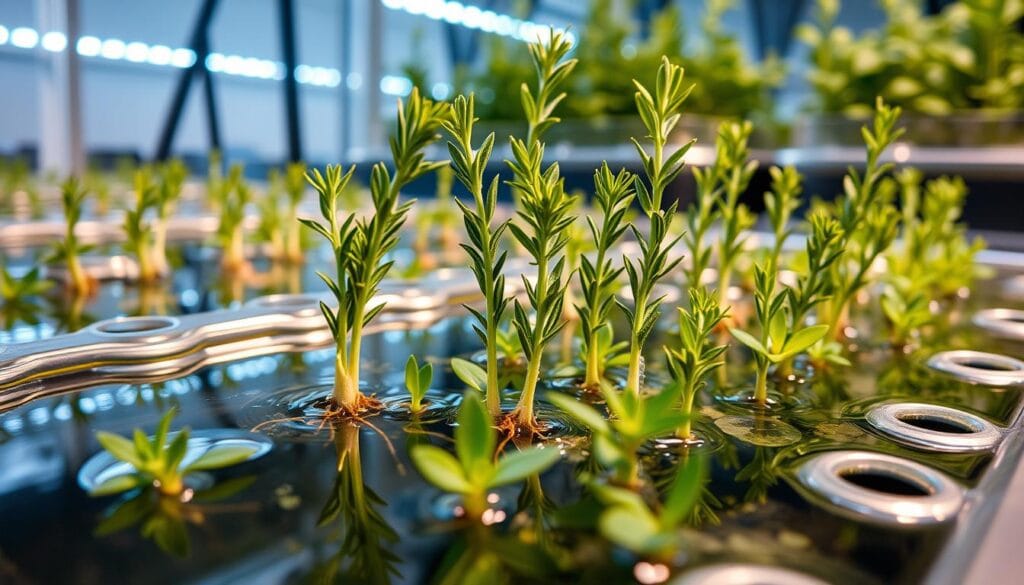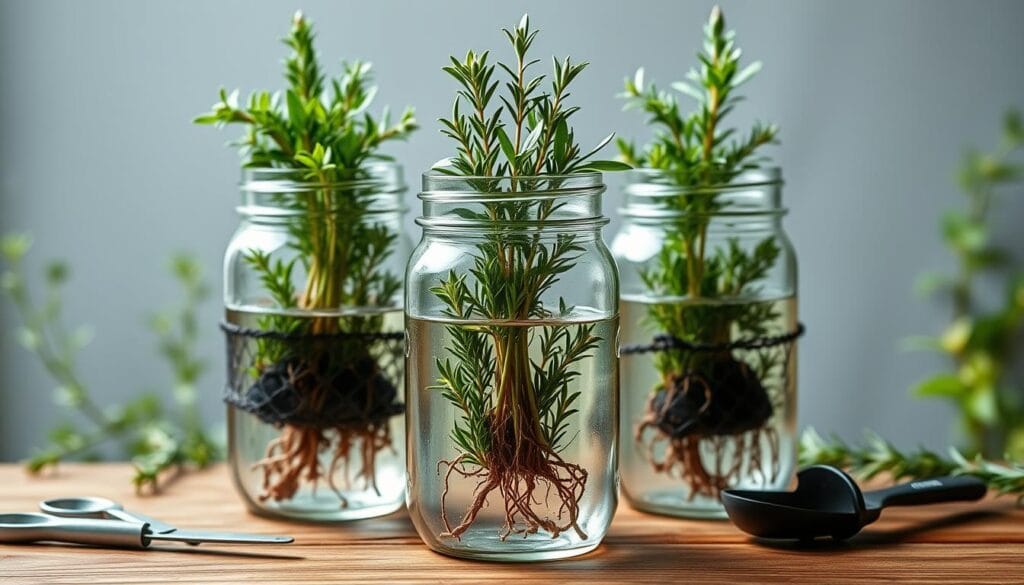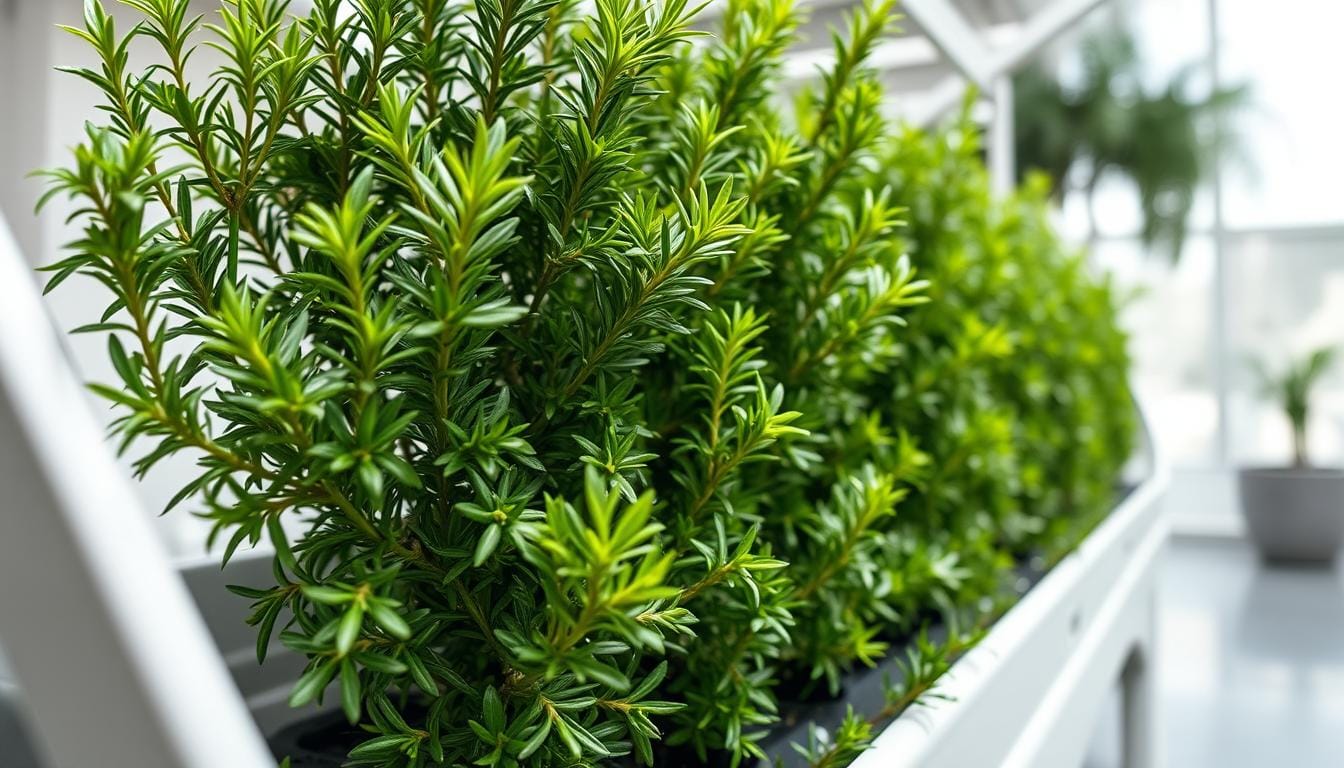Ever dreamed of growing fresh herbs right in your kitchen? No need to wrestle with traditional soil gardening. Indoor rosemary cultivation through hydroponics might be your perfect solution. I’ve turned my tiny apartment kitchen into a green sanctuary, and I know the magic of growing herbs effortlessly.
Hydroponic rosemary growing offers a new way to grow herbs. It gets rid of messy soil and makes the most of small spaces. Whether you love cooking or plants, learning to germinate rosemary in hydroponics lets you have fresh, nutrient-rich herbs right at your fingertips.
Key Takeaways
- Hydroponics allows year-round herb cultivation in compact spaces
- Rosemary thrives in water-based growing systems with proper nutrients
- Mason jars can be transformed into efficient hydroponic herb gardens
- LED lighting and controlled environments optimize herb growth
- Hydroponic systems promote faster plant development compared to soil methods
Understanding Hydroponic Gardening Basics
Hydroponic herb growing systems are a new way to grow plants. They don’t use soil like traditional gardening. This method lets you grow plants like rosemary in water, perfect for indoor and urban gardening.
Soilless rosemary propagation through hydroponics changes how we grow plants. It suspends roots in water with nutrients, helping plants grow fast.
What Makes Hydroponics Different from Soil Growing
Hydroponic herbs stand out in several ways:
- Precise nutrient control
- Faster plant growth rates
- Reduced water consumption
- Elimination of soil-based pest problems
- Year-round cultivation
Essential Components of a Hydroponic System
To grow rosemary without soil, you need certain tools:
- Net pots for plant suspension
- Growing medium (like perlite or coconut fiber)
- Nutrient solution
- Air pump for root oxygenation
- pH testing kit
Benefits of Hydroponic Herb Cultivation
“Hydroponics transforms limited spaces into productive green environments” – Urban Gardening Experts.
Hydroponic herbs have big benefits. NASA found they use 90% less water than regular farming. They let you grow vertically, use small spaces well, and produce herbs all year.
With the right setup and care, your hydroponic rosemary will flourish. It will give you fresh herbs right from your home.
Required Materials and Equipment Setup
To set up a successful rosemary hydroponics system, you need to pick the right parts. Your system must have key items for healthy plant growth and good nutrient flow.
- Mason jars or growing containers
- Net pots for root support
- Growing medium (clay pellets or coconut coir)
- Hydroponic nutrient solution
- Air pump and air stone
- Flexible tubing
- LED grow lights
When choosing your hydroponic parts, think about what rosemary needs. These herbs need the right environment to grow well in hydroponics.
“Success in hydroponic gardening comes from understanding each component’s role in plant nutrition and growth.” – Hydroponic Experts
The type of system you pick will affect how you set it up. Beginners might like these systems:
| Hydroponic System | Complexity | Rosemary Suitability |
|---|---|---|
| Wick System | Low | Good for small plants |
| Water Culture | Medium | Moderate compatibility |
| Ebb and Flow | Medium-High | Excellent for herbs |
It’s important to prepare your system parts well. Clean everything before you start, and make sure your nutrient solution is right for herbs.
With the right tools and attention to detail, you’ll make a great place for growing strong, tasty rosemary in your hydroponic garden.
Preparing Your Hydroponic Environment
To grow rosemary hydroponically, you need to focus on a few key things. Success in growing rosemary hydroponically depends on the right growing conditions.
Temperature and Humidity Management
Rosemary needs a specific climate to thrive. The best temperature for rosemary is between 65°F to 75°F (18°C to 24°C). Your hydroponic setup must keep the temperature steady for healthy growth.
- Keep ambient temperature steady between 65-75°F
- Avoid extreme temperature fluctuations
- Use thermometers to monitor environmental conditions
Lighting Requirements for Rosemary
Light is essential for rosemary’s growth. Aim to provide 6 to 8 hours of bright, direct light daily. Full-spectrum LED grow lights are best for indoor setups.
- Position grow lights 20-30 cm above plants
- Use timers to maintain consistent light exposure
- Recommended light duration: 12-16 hours per day
Water Quality and Nutrient Solutions
Water quality is critical in hydroponics. Use filtered water to avoid harmful minerals and ensure nutrient absorption.
“In hydroponics, water is more than just a medium—it’s the lifeline of your plants.”
- Use clean, filtered water
- Monitor pH levels carefully
- Mix nutrient solutions precisely
- Avoid standing water to prevent root rot
By managing these factors well, you’ll have a great hydroponic setup for growing healthy rosemary plants.
Germinate Rosemary in Hydroponics

Starting rosemary seeds in hydroponics needs careful steps and the right environment. First, pick high-quality seeds. Then, create a perfect place for them to grow.
To start growing rosemary seeds, follow these key steps:
- Prepare sterile starter plugs for hydroponic seed starting
- Soak the plugs well to keep them moist
- Put 2-3 rosemary seeds per plug for better chances of growing
- Keep the moisture right by misting gently every day
“Patience is key in rosemary seed germination – expect sprouts within 20-25 days under optimal conditions.”
Rosemary seed germination in hydroponics needs specific conditions:
| Parameter | Ideal Conditions |
|---|---|
| Temperature | 65°F to 75°F (18°C to 24°C) |
| Light Exposure | 12-16 hours daily under grow lights |
| Germination Rate | Approximately 30% |
Pro tip: Once seedlings appear, thin them to the strongest one per plug. This helps your rosemary plants grow strong in your hydroponic system.
Remember, rosemary seeds have a low germination rate. Planting more seeds boosts your chances of success. Keep the moisture right, light up their space well, and watch them grow.
Selecting the Right-Growing Medium
Choosing the right hydroponic growing mediums is key for growing rosemary. The medium you pick affects the plant’s health, growth, and how much it produces.
Rosemary needs specific conditions for growth. Some mediums are better than others for your hydroponic herb garden.
Comparative Medium Evaluation
- Perlite: Lightweight and great for drainage
- Offers the best aeration for rosemary roots
- Keeps water from pooling
- Rockwool: Holds moisture well
- Guarantees even water distribution
- Helps roots grow strong at first
- Coconut Coir: An eco-friendly choice
- Is good for the planet
- Keeps water well
- Clay Pebbles (LECA): Can be reused and stable
- Supports roots well
- Allows for great oxygen flow
Medium Preparation Best Practices
Preparing your hydroponic mediums needs careful steps. First, rinse the medium well to get rid of dust and harmful stuff.
“The success of your rosemary cultivation depends on the quality of your growing medium preparation.” – Hydroponic Gardening Expert.
Soak the medium in pH-balanced water before adding seeds or cuttings. This makes sure the medium is moist and ready for rosemary roots to grow.
Selection Recommendations
For rosemary, look for mediums that:
- Drain well
- Let oxygen in
- Keep moisture steady
- Support roots well
Remember, your hydroponic mediums are the base for growing rosemary. Pick the best ones and watch your herbs flourish!
Setting Up Your Mason Jar System
Starting a DIY hydroponic system with mason jars is fun and easy. It lets you grow fresh rosemary at home with little space. This method is efficient and space-saving.

To start your mason jar hydroponics project, you’ll need a few things:
- Clean mason jars (pint or quart size)
- Net pots
- Growing medium
- Nutrient solution
- Air stone
- Small rocks for drainage
Setting up your DIY hydroponic system needs some care. First, clean the mason jars well to avoid bacteria. Then, add an inch of small rocks at the bottom for better drainage and root health.
According to Hydroponic Experts, “Hydroponics is more than just gardening; it’s a scientific method for growing plants with precision and efficiency.”
| Mason Jar Size | Best For | Recommended Herbs |
|---|---|---|
| Print Size | Small Herbs | Rosemary, Thyme |
| Quart Size | Larger Herbs | Basil, Mint |
Put your net pots on the jar rims carefully. Make sure they’re stable. Fill the jars with nutrient solution, leaving room for an air stone. Proper air circulation is key for healthy roots in your hydroponic system.
When adding your rosemary seedlings, make sure their roots touch the nutrient solution. Place your mason jar hydroponics in a bright spot or under grow lights for the best growth.
Managing Water and Nutrient Levels
Hydroponic nutrient management is key for growing rosemary well. Your plants rely on the nutrient solution you give them. So, managing it well is vital for their health.
Learning about nutrient solutions can change your hydroponic gardening. The right method helps your rosemary grow strong and healthy.
pH Balance Monitoring for Rosemary
Keeping the pH right is important for rosemary in hydroponics. The best pH is between 5.5 and 6.5. This lets your rosemary absorb nutrients well. Here’s how to keep an eye on it:
- Use a digital pH meter weekly
- Check solution consistency
- Adjust pH using calibration solutions
- Maintain stable readings
Nutrient Solution Mixing Guide
Making the perfect nutrient solution needs care and knowledge. Your rosemary plants do best with balanced nutrients.
| Nutrient | Recommended Concentration (ppm) |
|---|---|
| Nitrogen | 150-200 |
| Phosphorus | 31-50 |
| Potassium | 210-280 |
| Calcium | 150-200 |
| Magnesium | 50-70 |
Here are some tips for managing nutrients well:
- Refresh nutrient solution every 2-3 weeks
- Monitor water levels daily
- Top up with plain water to maintain concentration
- Use electrical conductivity (EC) meter for precision
As stated by a Hydroponic Expert, “Successful hydroponic gardening is a delicate art of balance and precision.”
Mastering hydroponic nutrient management helps your rosemary thrive.
Light Management and Positioning
Perfecting hydroponic lighting is essential for successfully growing rosemary. Your rosemary needs specific light to grow and stay healthy.
LED grow lights are great for hydroponic rosemary. They offer many benefits:
- Full-spectrum coverage like natural sunlight
- They use less energy
- Light is spread evenly
- You can adjust the light’s intensity and time
“Proper lighting is the cornerstone of successful hydroponic herb cultivation.” – Herb Growing Experts
Here are important tips for placing your hydroponic lights:
- Keep lights 20-30 cm above the plants
- Give 12-16 hours of light every day
- Use timers for light cycles
Different light colors affect rosemary in different ways:
| Light Spectrum | Growth Impact |
|---|---|
| Blue Spectrum | Promotes leaf growth |
| Red Spectrum | Boosts essential oil production |
| Full Spectrum | Helps with overall plant health |
Pro tip: Rotate your hydroponic system now and then. This ensures light is spread evenly and prevents uneven growth.
Common Issues and Troubleshooting
Growing rosemary hydroponically can be tricky for herb lovers. Knowing about hydroponic rosemary problems is key to keeping your plants healthy. This ensures a good harvest.
Identifying Growth Problems
Spotting stress in your hydroponic rosemary early is vital. Look out for these signs:
- Yellow leaves mean you might need more nitrogen
- Brown tips on leaves could be from too much nutrients
- Stunted growth or wilting is a red flag
- Unusual color on roots is a warning sign
Resolving Common Hydroponic Challenges
To grow hydroponic rosemary well, you need to act fast. Here are some fixes for common problems:
| Problem | Solution |
|---|---|
| Root Rot | Boost oxygen, lower water temperature |
| Nutrient Imbalance | Check pH, use balanced nutrients |
| Pest Infestation | Try organic pest control, keep plants separate |
“Prevention is always better than cure in hydroponic herb gardening.” – Herb Growing Expert
Keeping your hydroponic rosemary system in top shape is critical. Keep it clean, check nutrient levels often, and ensure enough light. This helps avoid many issues.
Pest Management Strategies
Spider mites can be a big problem for indoor rosemary. Here’s how to prevent them:
- Check plants every week for pests
- Use neem oil to keep pests away
- Keep humidity right
- Quarantine new plants before adding them
Remember, the secret to growing great hydroponic rosemary is a balanced, stable environment. This supports healthy plants all the time.
Maintaining Healthy Rosemary Growth
Keeping your hydroponic rosemary healthy needs regular care and smart planning. Your garden’s health depends on a few important steps. These steps help your plants grow strong and stay healthy.
Pruning is key for a lush herb garden. Regular cuts help your plants grow bushy and prevent them from getting too long. Cut off about one-third of the plant, focusing on the outer branches. This encourages new growth.
- Clean hydroponic system components bi-weekly
- Monitor nutrient levels carefully
- Ensure adequate airflow around plants
- Harvest outer leaves systematically
Managing nutrients is vital for your rosemary’s health. Watch how your plants grow and adjust the nutrients they get. Your rosemary needs the right mix of nutrients to do well in a hydroponic setup.
*”Precision in plant care transforms good gardens into exceptional ones.”*
| Care Aspect | Recommended Action | Frequency |
|---|---|---|
| System Cleaning | Disinfect components | Every 2 weeks |
| Nutrient Monitoring | Check pH and nutrient levels | Weekly |
| Pruning | Trim outer branches | Monthly |
Success in growing herbs comes from watching and adjusting. Look for signs of trouble, like color changes or slow growth. Fix problems fast to keep your hydroponic rosemary happy and healthy.
Conclusion
Indoor herb gardening with hydroponics is a new way to grow fresh rosemary all year. This guide shows you how to make your home a place where herbs thrive easily. It’s simple and efficient.
To grow successful hydroponic rosemary, you need to control the environment well. You must also manage nutrients and care for your plants. This method saves water, grows herbs fast, and works in any weather.
By using hydroponics, you can have fresh rosemary whenever you want. It’s a green way to get food and a fun hobby. It lets you watch your plants grow and learn more about gardening.
As you get better, you’ll learn more about growing rosemary with hydroponics. Every time you harvest, you’ll feel more confident. Your indoor gardening will become a joy and a success.

